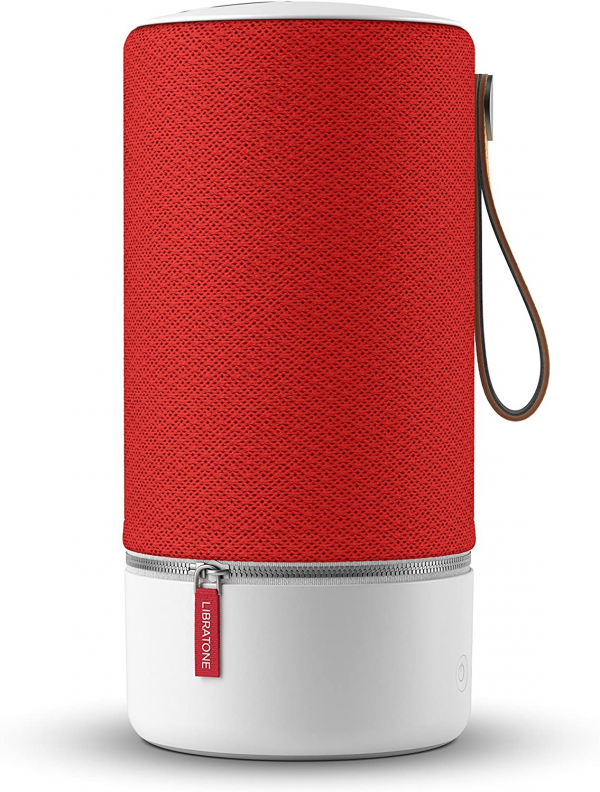Libratone
Libratone Zipp speaker takes off her dress
Aprox. 152€
See specificationsIn the category of transportable speakers, the new Zipp by Libratone uses the same recipe as the first of its kind, namely 360-degree sound diffusion, a removable cover and complete connectivity. The multiroom is also in the game and the autonomy has been revised upwards. Libratone therefore keeps all the elements that we liked about the old version and adds new ones.
Positive points
Powerful and faithful sound rendering.
Distortion under control.
360 ° diffusion.
Finish.
Stable and complete application.
Multiroom.
Bluetooth.
Ease of use.
Airplay.
Spotify Connect.
Full connectivity.
Charging a mobile device.
Bad points
No NFC chip.
Application only in English.
Our review
Ergonomics
The Libratone Zipp has a very nice finish: the base and the upper part of the plastic enclosure are coated with a white satin surface. The black handle is securely attached to the speaker and the mesh fabric cover is interchangeable. To do this, simply locate the zipper and "zzzipppp!", You change color: green, red, gray or black, depending on your zzzinspirations.
Libratone creates a real control interface with the presence of a tactile surface allowing to control the sound directly on its speaker: pairing between the speakers, play / pause, song change, volume adjustment, up to 5 favorite radio stations, answer or reject a call , mute mode by putting your hand on the interface and indication of the battery level.
In terms of connectivity, the Zipp offers a complete solution with the presence of Bluetooth 4.0 (aptX codec), Airplay (iOS), DLNA (Android / Windows), a mini-jack port and a USB port, allowing you to charge your mobile device. The autonomy of the Zipp is about 9 hours (at 75% of the volume in continuous reading).
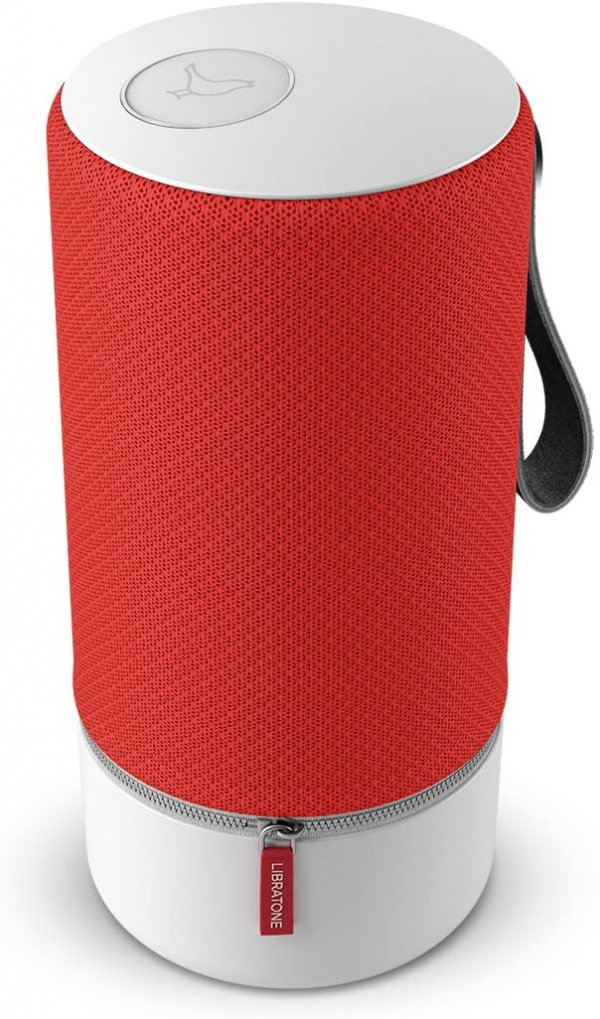
Multimedia
Wi-Fi (dual band 2.4 GHz and 5 GHz) is also part of the game and allows you to use the Zipp in multiroom - also possible via Bluetooth. The speakers are linked together either via the touch interface or through the application - very practical: it is enough to connect only one to the network so that all the others are also connected.
The application - only available in English - provides access to different sound modes ranging from rock configuration to listening to film, through jazz or classical. Another parameter allows you to adjust the DSP depending on where the speaker is located (exterior, shelf, table, floor). We can also choose to rename the speaker, create different listening spaces or even configure the favorite webradios. The Zipp is compatible with Spotify Connect.
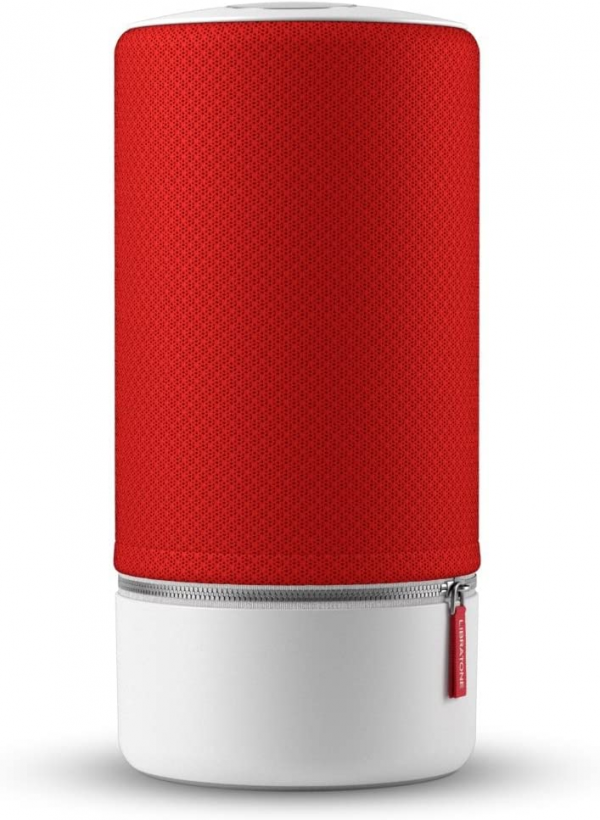
Audio
Like the old version, the Zipp delivers 360-degree sound. The audio part consists of a 10 cm woofer coupled to two 10 cm low frequency radiators to recreate the bass and two 2.5 cm tweeters with flexible dome for treble reproduction. The whole is amplified by a class D amplifier developing a total power of 100 W on two supply channels. According to the manufacturer, this portable speaker reproduces a range of frequencies ranging from 50 Hz to 20 kHz.
As can be seen on the curve below, the frequency rendering varies very little depending on the orientation of the speaker. A real work of sound homogeneity has therefore been carried out with regard to omnidirectional broadcasting.
On the audio side, the Zipp is also doing very well. The audio rendering is linear and meets the criteria of fidelity. Without being too flattered, the bass is present, rather reactive, and even if they do not descend very low in the audible spectrum, they remain extremely correct for a speaker of this size. The promise of a rendering that extends from 50 Hz to 20 kHz is fulfilled, even if, in fact, the bass is really manifested from 80 Hz. The mids are well defined and the voices clear, faithful and intelligible. The membranes do not generate wheezing at the top of the spectrum, even at high volume. The treble is well defined, although they could be a little more present. On the whole, the instruments present on the sound stage are well transcribed.
Above, we observe the impact of the different available presets on the frequency response: acting quite subtly, they work rather well. Finally, we only regret not having access to a real equalizer to create our own sound signature.
This distortion measurement was made at 85 dB, which is a rather high volume for a nomadic product. We usually do not publish this kind of measurement for portable speakers, the distortion rate is so easy. With the Libratone, however, even the most sensitive THD measurement (in Bluetooth) remains honorable, with an average of 0.24% - the audible threshold is 1% - between 80 Hz and 20 kHz.
The Bluetooth latency of around 200 ms makes this speaker unsuitable for watching videos due to the noticeable sound / image lag. It is however possible to go through Wi-Fi, in which case the latency becomes imperceptible.
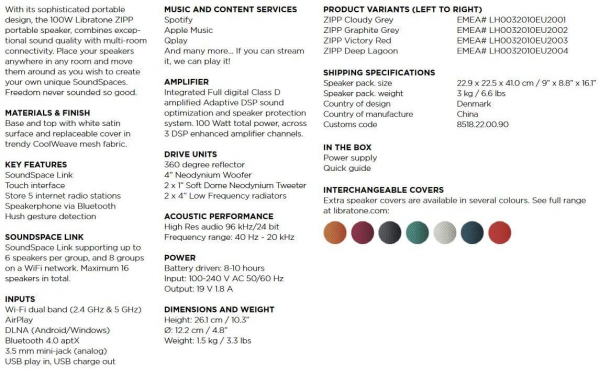
Conclusion
With the renewal of its famous Zipp, Libratone once again shows us its expertise in portable speakers. This model is a real success for the Danish manufacturer on all fronts: if the Zipp can easily adorn itself with different colors, it also knows how to make an audio side by offering a faithful sound rendering accompanied by a beautiful power, the whole being diffused homogeneously over 360 °.
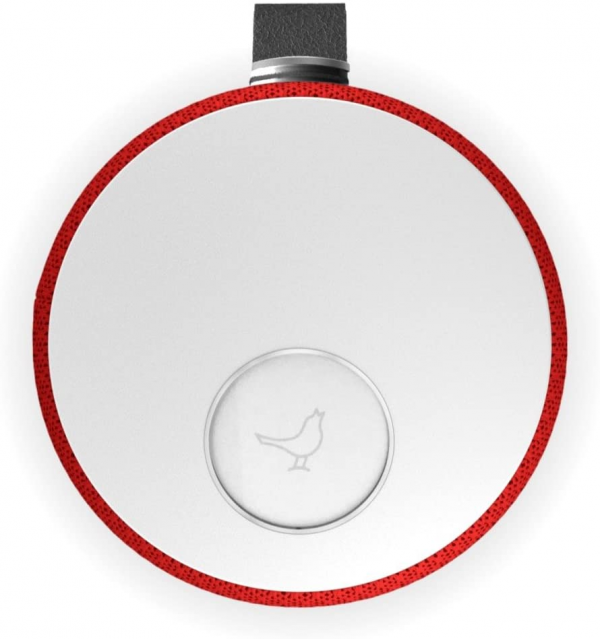
Specifications

